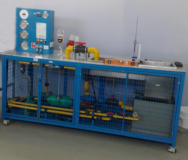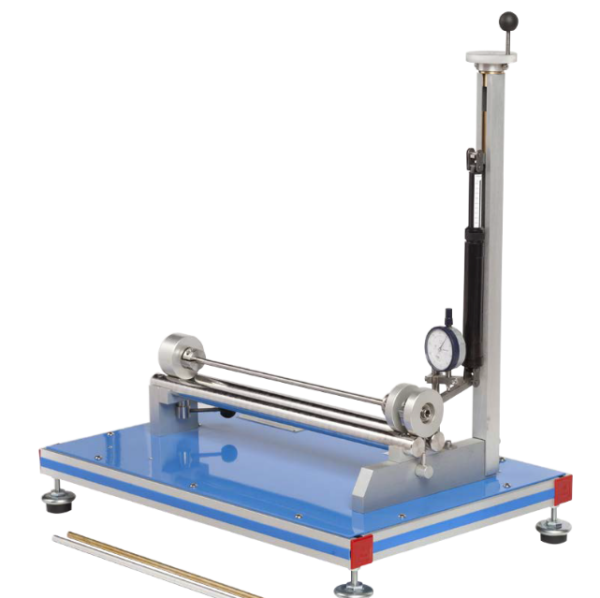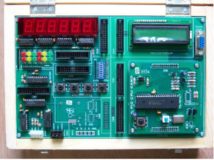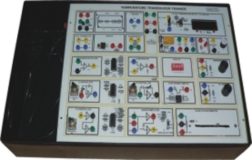Torsion Test Apparatus Model MT 097
Home » Products » Torsion Test Apparatus Model MT 097
Torsion Test Apparatus Model MT 097
Sci-tech Torsion Test Apparatus Model MT 097 allows to verify the basis of torsion and to perform practical exercises to demonstrate:
– Circular rods elastic torsion equation.
– The rigidity modulus of different materials.
To perform the tests a metallic rod is fastened by clamps and subjected to the testing force. Force is gradually applied on the rod to observe the elastic tension generated. The force moment or torque is applied by a dynamometer with a lever. Deformation generated by the torsional stress is obtained by reading a dial gauge in contact with the arm. The torsional deformation angle is obtained by a simple trigonometric identity, providing the unit with important didactic characteristics.
Steel, brass and aluminum rods are supplied to perform the practical exercises. Additionally, rods made of other materials can be employed.
| Size: | 140cm x 70cm x 50cm (LxWxH) |
| Weight: | 45 kg |
Item Description
Features
- Generate the twisting moment by means of a worm gear
- Measure the twisting moment by means of a strain-gauge measuring shaft
- Incremental encoder for measuring the twisting angle
Torsion is a type of stress that appears when applying a moment or torque on a rod or element. The transverse sections of the rod suffer a twisting around an axis normal to its plane where tangential stresses analogous to the simple shear stresses are developed.
Its application in industry is crucial, since all the axes of the machines that rotate and transfer motion are subjected to torsional stress.
Sci-tech Torsion Test Apparatus Model MT 097 allows to verify the basis of torsion and to perform practical exercises to demonstrate:
– Circular rods elastic torsion equation.
– The rigidity modulus of different materials.
To perform the tests a metallic rod is fastened by clamps and subjected to the testing force. Force is gradually applied on the rod to observe the elastic tension generated. The force moment or torque is applied by a dynamometer with a lever. Deformation generated by the torsional stress is obtained by reading a dial gauge in contact with the arm. The torsional deformation angle is obtained by a simple trigonometric identity, providing the unit with important didactic characteristics.
Steel, brass and aluminum rods are supplied to perform the practical exercises. Additionally, rods made of other materials can be employed.
Bench-top unit with adjustable legs.
Anodized aluminum frame and panels in painted steel.
The apparatus mainly consists of:
– Main frame that is supported on two aluminum blocks. It consists of two guides made of stainless steel. The rest of the components are made of aluminum.
– Two guides of the unit on which the mobile clamp slides are for testing rods of different lengths.
– Mobile clamp located at one end that has a crank in the bottom to adjust the test rod to the desired length. It is made of stainless steel.
– Fixed clamp, consists of two bearings which allow it to turn. It has an arm on which the force is applied. It has a notch placed 60 mm from the longitudinal axis of the test rod, to carry out the measurements. The dial gauge should be placed on this notch to properly measure the deformation. The clamp is made of stainless steel.
– Test rods: standard supply of 3 test rods made of steel, brass and aluminum. They are 8 mm in diameter and 350 mm in length. They have marks every 50 mm, to make the performance of practical exercises at different lengths easier.
– A Dynamometer up to 10 Kg, with a 50 g accuracy, to apply the forces on the test rod.
– A Dial gauge of 0- 10 mm, with 0.01 mm accuracy, to measure the deformation of the test rod subjected to the force.
All the necessary tools to carry out the experiments are provided. One Allen key is supplied to adjust the dial gauge and one Allen key is supplied to tighten the clamps.
Manuals:
This unit is supplied with the following manuals: Required Services, Assembly and Installation, Starting-up, Safety, Maintenance & Practices Manuals.
See also different:

The experiments familiarize students with various pump types, such as centrifugal and positive-displacement pumps. Sci-tech Pumps Comparison Apparatus Model FM 95 includes two centrifugal pumps, one piston pump as a positive-displacement pump [...]



